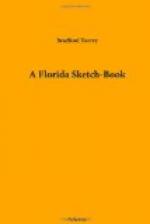Here, too, in the heart of the town, was a magnificent cluster of live-oaks, worth coming to Florida to see; far-spreading, full of ferns and air plants, and heavy with hanging moss. Day after day I went out to admire them. Under them was a neglected orange grove, and in one of the orange-trees, amid the glossy foliage, appeared my first summer tanager. It was a royal setting, and the splendid vermilion-red bird was worthy of it. Among the oaks I walked in the evening, listening to the strange low chant of the chuck-will’s-widow,—a name which the owner himself pronounces with a rest after the first syllable. Once, for two or three days, the trees were amazingly full of blue yellow-backed warblers. Numbers of them, a dozen at least, could be heard singing at once directly over one’s head, running up the scale not one after another, but literally in unison. Here the tufted titmouse, the very soul of monotony, piped and piped and piped, as if his diapason stop were pulled out and stuck, and could not be pushed in again. He is an odd genius. With plenty of notes, he wearies you almost to distraction, harping on one string for half an hour together. He is the one Southern bird that I should perhaps be sorry to see common in Massachusetts; but that “perhaps” is a large word. Many yellow-throated warblers, silent as yet, were commonly in the live-oaks, and innumerable myrtle birds, also silent, with prairie warblers, black-and-white creepers, solitary vireos, an occasional chickadee, and many more. It was a birdy spot; and just across the way, on the shrubby island, were red-winged blackbirds, who piqued my curiosity by adding to the familiar conkaree a final syllable,—the Florida termination, I called it,—which made me wonder whether, as has been the case with so many other Florida birds, they might not turn out to be a distinct race, worthy of a name (Agelaius phoeniceus something-or-other), as well as of a local habitation. I suggest the question to those whose business it is to be learned in such matters.[1]




